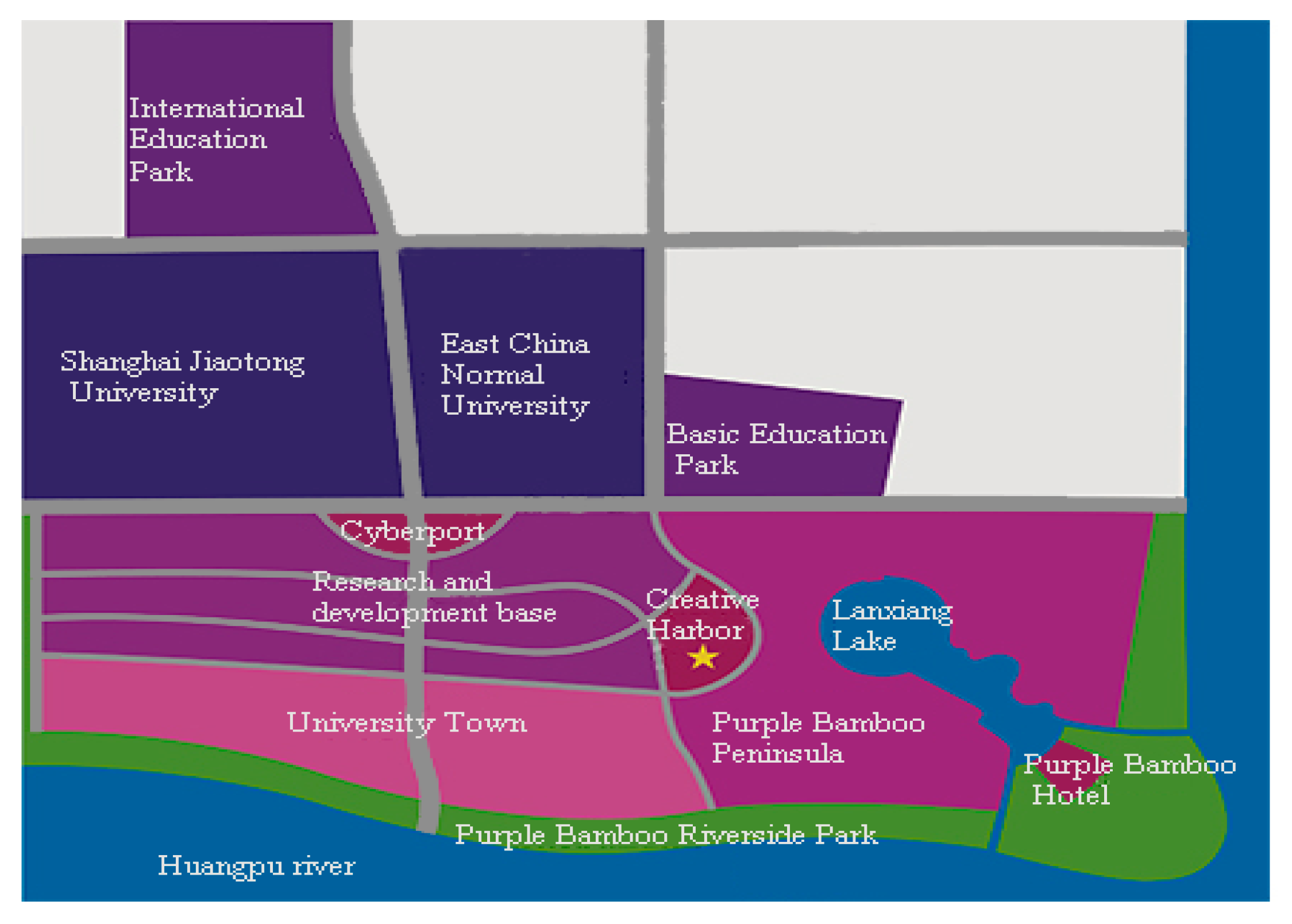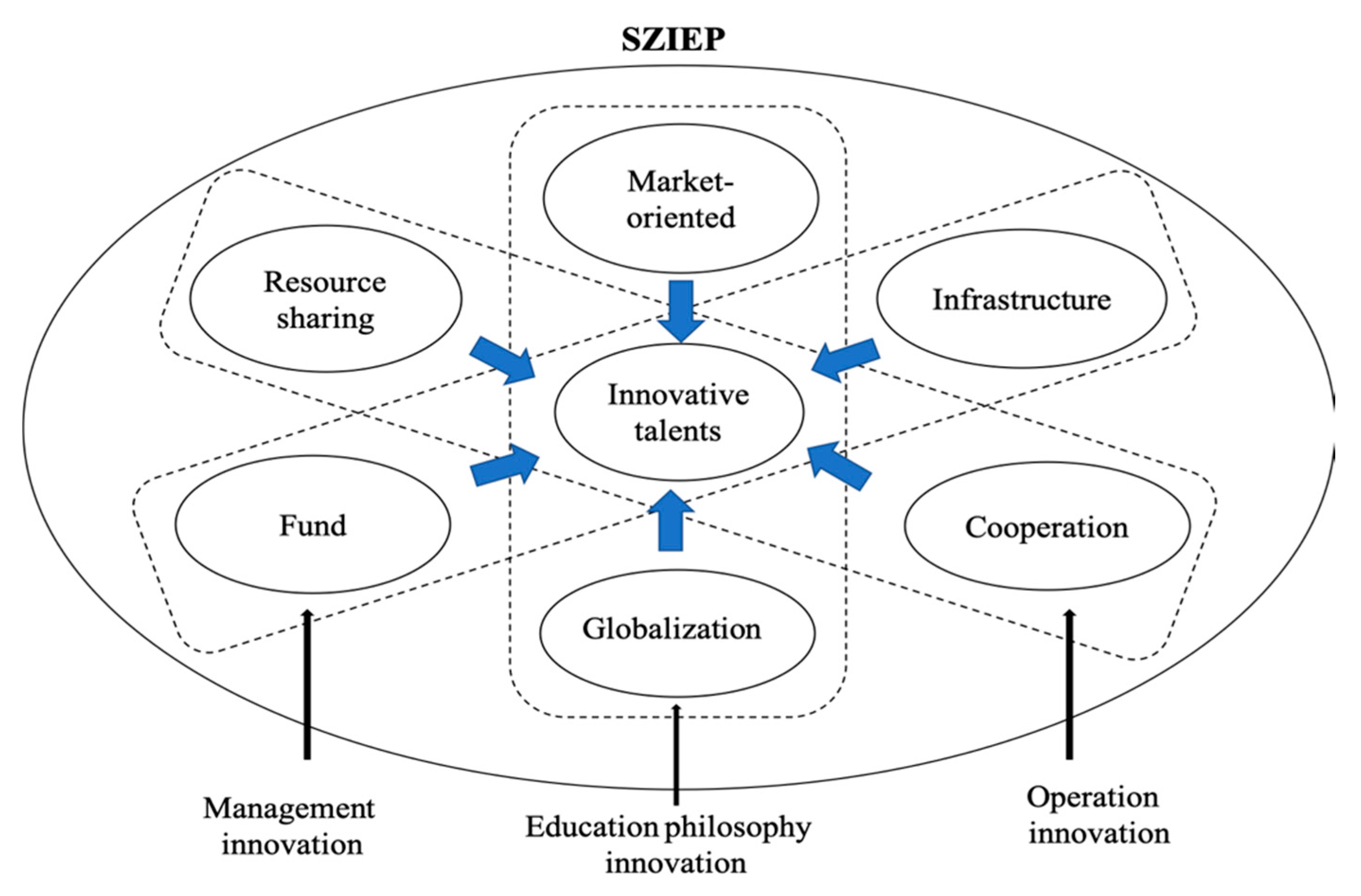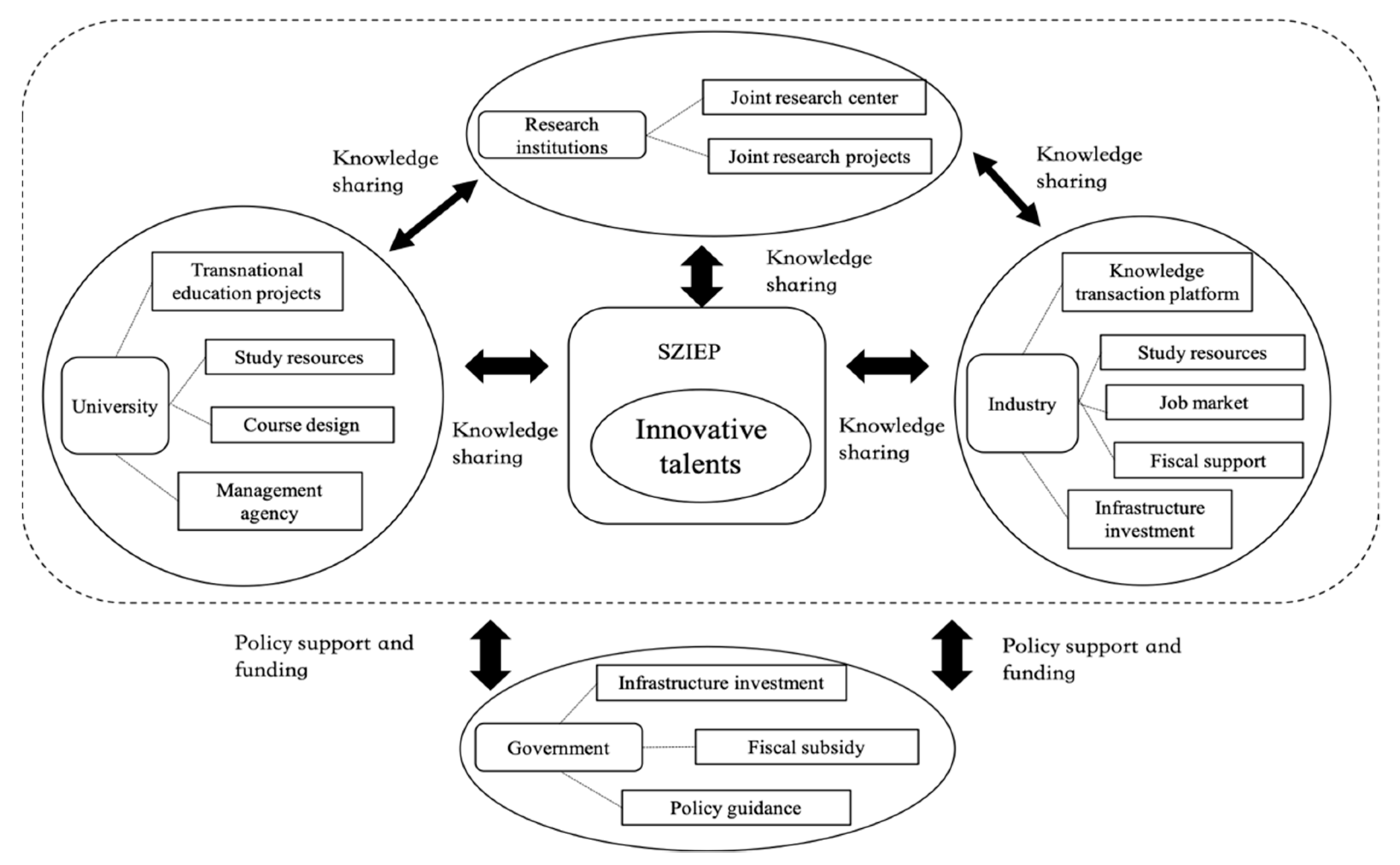Internal and External Coordinated Open Innovation Ecosystems: Concept Building and Applying to Shanghai Zizhu International Education Park
Abstract
1. Introduction
2. Literature Review
2.1. The Concept of an Open Innovation Ecosystem
2.2. The Open Innovation Ecosystem of Higher Education
3. Research Methodology
3.1. Qualitative Data Analysis and Case Selection
3.2. Introduction of SZIEP
3.3. Data Collection
4. Findings
4.1. Internal Open Innovation Ecosystem of SZIEP (Micro-Perspective)
4.2. External Open Innovation Ecosystem of SZIEP (Macro-Perspective)
5. Discussion: Open Innovation, Ecosystem, and System Dynamic Feedback Loop
5.1. Systems Thinking of the Open Innovation Ecosystem of Higher Education
5.2. Conclusion and Future Study
Author Contributions
Funding
Conflicts of Interest
References
- Kankanhalli, A.; Zuiderwijk, A.; Tayi, G.K. Open innovation in the public sector: A research agenda. Gov. Inf. Q. 2017, 34, 84–89. [Google Scholar] [CrossRef]
- Etzkowitz, H.; Leydesdorff, L. The dynamics of innovation: From National Systems and “Mode 2” to a Triple Helix of university–industry–government relations. Res. Policy 2000, 29, 109–123. [Google Scholar] [CrossRef]
- Leydesdorff, L.; Meyer, M. The scientometrics of a Triple Helix of university-industry-government relations (Introduction to the topical issue). Scientometrics 2007, 70, 207–222. [Google Scholar] [CrossRef]
- Piirainen, K.A.; Andersen, A.D.; Andersen, P.D. Foresight and the third mission of universities: The case for innovation system foresight. Foresight 2006, 18, 24–40. [Google Scholar] [CrossRef]
- Johannsson, M.; Wen, A.; Kraetzig, B.; Cohen, D.; Liu, D.; Liu, H.; Palencia, H.; Wagner, H.; Stotesbury, I.; Jaworski, J.; et al. Space and Open Innovation: Potential, limitations and conditions of success. Acta Astronaut. 2015, 115, 173–184. [Google Scholar] [CrossRef]
- Yun, J.J.; Zhao, X.; Yigitcanlar, T.; Lee, D.; Ahn, H. Architectural design and open innovation symbiosis: Insights from research campuses, manufacturing systems, and innovation districts. Sustainability 2018, 10, 4495. [Google Scholar] [CrossRef]
- Chesbrough, H.; Kim, S.; Agogino, A. Chez Panisse: Building an open innovation ecosystem. Calif. Manag. Rev. 2014, 56, 144–171. [Google Scholar] [CrossRef]
- Yun, J.H.; Park, K.B.; Gaudio, G.D.; Corte, V.D. Open innovation ecosystems of restaurants: Geographical economics of successful restaurants from three cities. Eur. Plan. Stud. 2020, 1–20. [Google Scholar] [CrossRef]
- Yun, J.J.; Won, D.; Park, K.; Yang, J.; Zhao, X. Growth of a platform business model as an entrepreneurial ecosystem and its effects on regional development. Eur. Plan. Stud. 2017, 25, 805–826. [Google Scholar] [CrossRef]
- West, J.; Bogers, M. Leveraging external sources of innovation: A review of research on open innovation. J. Prod. Innov. Manag. 2014, 31, 814–831. [Google Scholar] [CrossRef]
- Bektaş, C.; Tayauova, G. A Model Suggestion for Improving the Efficiency of Higher Education: University–Industry Cooperation. Procedia-Soc. Behav. Sci. 2014, 116, 2270–2274. [Google Scholar]
- Marques, J.P.; Caraça, J.M.; Diz, H. How can university–industry–government interactions change the innovation scenario in Portugal?—The case of the University of Coimbra. Technovation 2006, 26, 534–542. [Google Scholar] [CrossRef]
- Zhou, W.; Li, Y.; Hsieh, C.J.; Chang, K.C.; Kiang, Y.J.; Ken, Y. Research Performance and University–Industry–Government Funding Sources in Taiwan’s Technological and Vocational Universities. Innovation 2016, 18, 340–351. [Google Scholar] [CrossRef]
- McAdam, M.; Debackere, K. Beyond ‘triple helix’ toward ‘quadruple helix’ models in regional innovation systems: Implications for theory and practice. RD Manag. 2018, 48, 3–6. [Google Scholar] [CrossRef]
- Perkmann, M.; Walsh, K. University–industry relationships and open innovation: Towards a research agenda. Int. J. Manag. Rev. 2007, 9, 259–280. [Google Scholar] [CrossRef]
- Inzelt, A. The evolution of university–industry–government relationships during transition. Res. Policy 2004, 33, 975–995. [Google Scholar] [CrossRef]
- Poyago-Theotoky, J.; Beath, J.; Siegel, D.S. Universities and fundamental research: Reflections on the growth of university–industry partnerships. Oxf. Rev. Econ. Policy 2002, 18, 10–21. [Google Scholar] [CrossRef]
- Jensen, M.B.; Johnson, B.; Lorenz, E.; Lundvall, B.Å.; Lundvall, B.A. Forms of knowledge and modes of innovation. Learn. Econ. Econ. Hope 2007, 155. Available online: https://library.oapen.org/bitstream/handle/20.500.12657/31613/626406.pdf?sequence=1#page=172 (accessed on 13 October 2020). [CrossRef]
- Nam, G.M.; Kim, D.G.; Choi, S.O. How Resources of Universities influence Industry Cooperation. J. Open Innov. Technol. Mark. Complex. 2019, 5, 9. [Google Scholar] [CrossRef]
- Chesbrough, H.W. Open Innovation: The New Imperative for Creating and Profiting from Technology; Harvard Business Press: Brighton, MA, USA, 2003. [Google Scholar]
- Chesbrough, H.W. The era of open innovation. Manag. Innov. Chang. 2006, 127, 34–41. [Google Scholar]
- Crescenzi, R.; Nathan, M.; Rodríguez-Pose, A. Do inventors talk to strangers? On proximity and collaborative knowledge creation. Res. Policy 2016, 45, 177–194. [Google Scholar] [CrossRef]
- Tani, M.; Papaluca, O.; Sasso, P. The system thinking perspective in the open-innovation research: A systematic review. J. Open Innov. Technol. Mark. Complex. 2018, 4, 38. [Google Scholar] [CrossRef]
- Yun, J.J.; Won, D.K.; Park, K.B. Entrepreneurial cyclical dynamics of open innovation. J. Evol. Econ. 2018, 28, 1151–1174. [Google Scholar] [CrossRef]
- Yun, J.J.; Zhao, X.; Jung, K.; Yigitcanlar, T. The Culture for Open Innovation Dynamics. Sustainability 2020, 12, 5076. [Google Scholar] [CrossRef]
- Shearmur, R.; Doloreux, D. How open innovation processes vary between urban and remote environments: Slow innovators, market-sourced information and frequency of interaction. Entrep. Reg. Dev. 2016, 28, 337–357. [Google Scholar] [CrossRef]
- Vega-Jurado, J.; Gutiérrez-Gracia, A.; Fernández-de-Lucio, I. Does external knowledge sourcing matter for innovation? Evidence from the Spanish manufacturing industry. Ind. Corps Chang. 2009, 18, 637–670. [Google Scholar] [CrossRef]
- Li, Y.R. The technological roadmap of Cisco’s business ecosystem. Technovation 2009, 29, 379–386. [Google Scholar] [CrossRef]
- Granstrand, O.; Holgersson, M. Innovation ecosystems: A conceptual review and a new definition. Technovation 2020, 90, 102098. [Google Scholar] [CrossRef]
- Jackson, D.J. What Is an Innovation Ecosystem? National Science Foundation: Alexandria, VA, USA, 2011. [Google Scholar]
- Li, W.; Chang, J.; Wang, M.J.; Zhu, X.; Jin, A. Innovation 3.0 and innovation ecosystem. Stud. Sci. Sci. 2014, 32, 1761–1770. [Google Scholar]
- Battistella, C.; Colucci, K.; De Toni, A.F.; Nonino, F. Methodology of business ecosystems network analysis: A case study in Telecom Italia Future Centre. Technol. Forecast. Soc. Chang. 2013, 80, 1194–1210. [Google Scholar] [CrossRef]
- Brandenburger, A.M.; Nalebuff, B.J. Co-Opetition; Crown Business: New York, NY, USA, 2011. [Google Scholar]
- Gobble, M.M. Charting the innovation ecosystem. Res.-Technol. Manag. 2014, 57, 55–59. [Google Scholar]
- Adner, R. Match your innovation strategy to your innovation ecosystem. Harv. Bus. Rev. 2006, 84, 98. [Google Scholar] [PubMed]
- Su, Y.S.; Zheng, Z.X.; Chen, J. A multi-platform collaboration innovation ecosystem: The case of China. Manag. Decis. 2018, 56, 87–104. [Google Scholar] [CrossRef]
- Gassmann, O.; Enkel, E.; Chesbrough, H. The future of open innovation. RD Manag. 2010, 40, 213–221. [Google Scholar] [CrossRef]
- Ye, J.; Kankanhalli, A. Exploring innovation through open networks: A review and initial research questions. IIMB Manag. Rev. 2013, 25, 69–82. [Google Scholar] [CrossRef][Green Version]
- Lubienski, C. Innovation in education markets: Theory and evidence on the impact of competition and choice in charter schools. Am. Educ. Res. J. 2003, 40, 395–443. [Google Scholar] [CrossRef]
- Yun, J.J.; Liu, Z. Micro and Macro Dynamics of Open Innovation with a Quadruple-Helix Mode. Sustainability 2019, 11, 3301. [Google Scholar] [CrossRef]
- Howells, J.; Ramlogan, R.; Cheng, S.L. Universities in an open innovation system: A UK perspective. Int. J. Entrep. Behav. Res. 2012, 18, 440–456. [Google Scholar] [CrossRef]
- Sun, S.L.; Zhang, Y.; Cao, Y.; Dong, J.; Cantwell, J. Enriching innovation ecosystems: The role of government in a university science park. Glob. Transit. 2019, 1, 104–119. [Google Scholar] [CrossRef]
- Senge, P.M. The Art and Practice of the Learning Organization; Doubleday: New York, NY, USA, 1990. [Google Scholar]
- Forrester, J.W. System dynamics, systems thinking, and soft OR. Syst. Dyn. Rev. 1994, 10, 245–256. [Google Scholar] [CrossRef]
- Abreu, A.; Urze, P. System thinking shaping innovation ecosystems. Open Eng. 2016, 1. [Google Scholar] [CrossRef]
- Yin, R.K. Case Study Research: Design and Methods; Sage Publications: London, UK, 2013. [Google Scholar]
- Eisenhardt, K.M. Building theories from case study research. Acad. Manag. Rev. 1989, 14, 532–550. [Google Scholar] [CrossRef]
- Leydesdorff, L. The Triple Helix of university-industry-government relations (February 2012). In Encyclopedia of Creativity, Innovation, and Entrepreneurship; Springer: New York, NY, USA, 2012; Available online: http://eprints.rclis.org/16559/1/The%20Triple%20Helix%20of%20University-Industry-Government%20Relations.Jan12.pdf (accessed on 13 October 2020).




| Institute | Time of Establishment | Co-Construction Institution | Student Educational Orientation | |
|---|---|---|---|---|
| 1 | USC-SJTU Institute of Cultural and Creative Industry | 2015 | University of Southern California (USA) Shanghai Jiao Tong University (China) PGMD, Shanghai ZIZHU | Training talents in art, technology, and management |
| 2 | Asia Europe Business School | 2015 | East China Normal University (China) Emlyon Business School (France) PGMD, Shanghai ZIZHU | Training talents in international and innovative management for the construction of countries along the “Belt and Road” |
| 3 | Joint Translational Science and Technology Research Institute | 2016 | East China Normal University (China) The University of Haifa (Israel) PGMD, Shanghai ZIZHU | Training talents in data science, neuroscience, biomedicine, and ecological environment. |
| 4 | Shanghai International College (Beijing Film Academy) | 2016 | Beijing Film Academy(China) PGMD, Shanghai ZIZHU | Training talents with creativity, technology, and management of the film and television industry. |
| 5 | Huaer Zizhu Lemania College | 2019 | East China Normal University, China Lemania Swiss Group of Schools, Switzerland PGMD, Shanghai ZIZHU | Training talent in pre-university education. |
| 6 | Shanghai Zizhu International Education College | 2012 | PGMD, Shanghai ZIZHU | Training talents in pre-university education, elite education, and undergraduate general education |
© 2020 by the authors. Licensee MDPI, Basel, Switzerland. This article is an open access article distributed under the terms and conditions of the Creative Commons Attribution (CC BY) license (http://creativecommons.org/licenses/by/4.0/).
Share and Cite
Yan, H.; Wang, L.; Yan, X.; Zhai, Q. Internal and External Coordinated Open Innovation Ecosystems: Concept Building and Applying to Shanghai Zizhu International Education Park. J. Open Innov. Technol. Mark. Complex. 2020, 6, 113. https://doi.org/10.3390/joitmc6040113
Yan H, Wang L, Yan X, Zhai Q. Internal and External Coordinated Open Innovation Ecosystems: Concept Building and Applying to Shanghai Zizhu International Education Park. Journal of Open Innovation: Technology, Market, and Complexity. 2020; 6(4):113. https://doi.org/10.3390/joitmc6040113
Chicago/Turabian StyleYan, Haiyan, Linlin Wang, Xinyue Yan, and Qiongbo Zhai. 2020. "Internal and External Coordinated Open Innovation Ecosystems: Concept Building and Applying to Shanghai Zizhu International Education Park" Journal of Open Innovation: Technology, Market, and Complexity 6, no. 4: 113. https://doi.org/10.3390/joitmc6040113
APA StyleYan, H., Wang, L., Yan, X., & Zhai, Q. (2020). Internal and External Coordinated Open Innovation Ecosystems: Concept Building and Applying to Shanghai Zizhu International Education Park. Journal of Open Innovation: Technology, Market, and Complexity, 6(4), 113. https://doi.org/10.3390/joitmc6040113




